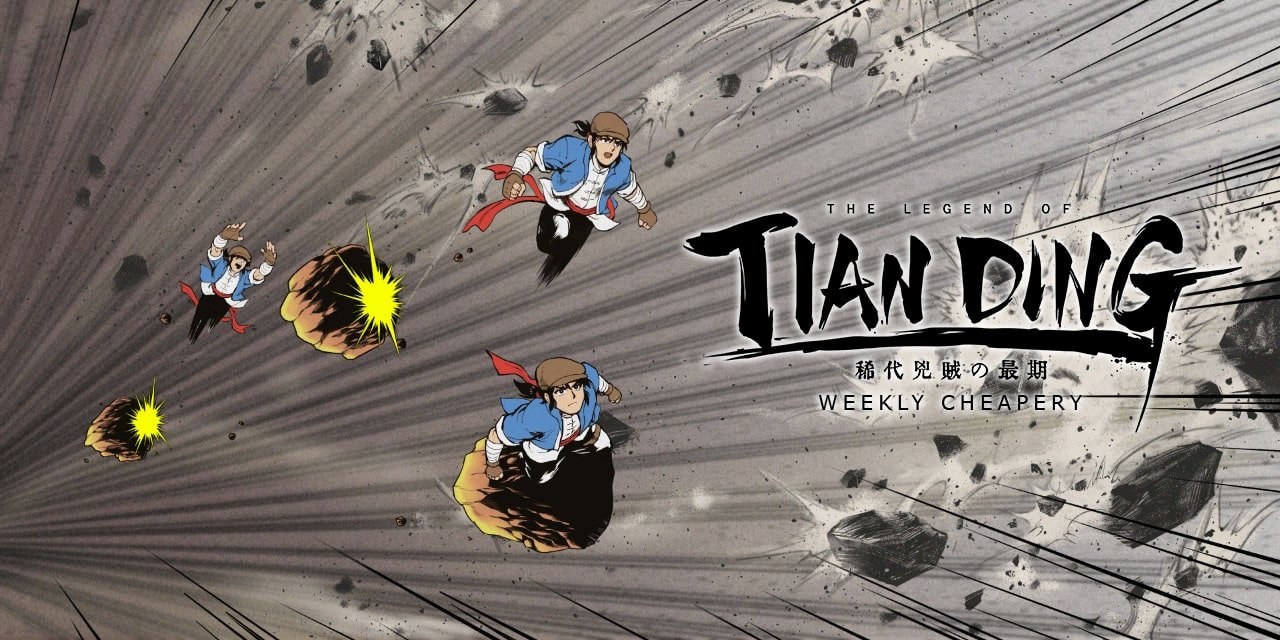Quick View
Game: The Legend of Tianding
Release Date: November 1, 2021
Price: $19.99
Rating: T for Teen
Platform: Windows, Switch
Geek to Geek Media was provided with a review copy of this title.
Sometimes it only takes a single screenshot to hook my interest in a game. When I first saw the stylized, comic book aesthetics of The Legend of Tianding, I was intrigued right away. It reminded me a bit of Okami in how it aimed to show a hand-drawn style in a 3D space. When I read that it was inspired by a Taiwanese folk-hero who is often compared to Robin Hood, I was even more hooked!
The parts are all great, but The Legend of Tianding absolutely adds up to more than the sum of its parts.
Flashy Style
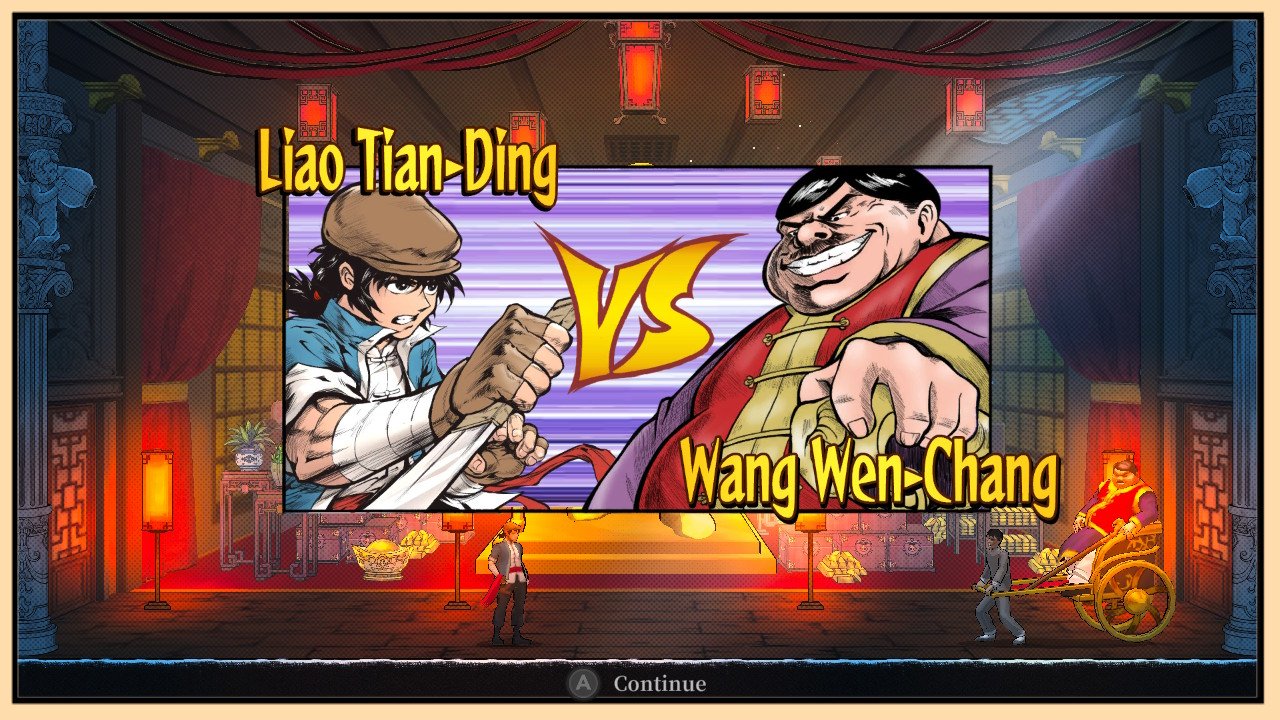
There are a few layers going on in the aesthetics of this game. The characters themselves are all pretty simple 3D polygons, but with a little bit of a black outline that really makes them stand out. It’s actually a bit reminiscent of Grand Theft Auto: China Town Wars. I tried zooming in on the characters using the Switch’s accessibility features a few times to see the details, and they actually look really muddy and uninteresting when you see them up close. At the normal size, they look absolutely wonderful.
The backgrounds are all rendered in a similar style, but with a little bit of a desaturated look and some halftone overlays. This makes sure that the characters stay visible, but also looks super cool. Any individual screenshot looks like an awesome, stylized comic book page, but seeing the backgrounds in motion really makes them shine. Whether you’re exploring a city or a sewer, there is a massive amount of depth in the environment. The camera stays closely locked on to your character as you move around, so the background is constantly panning as you move. It’s really hard to describe exactly how good this game looks in motion, so you should tune in to CapsuleJay’s stream to see the game in action!
The Story of The Legend of Tianding

I have to start by admitting that I went into The Legend of Tianding knowing absolutely nothing about the folk hero it’s inspired by or, to be honest, about Taiwanese culture or history in general. The story drops you in as Liao Tianding, a charismatic scoundrel and thief who is championed by the people for fighting against an oppressive force. There’s a lot of similarities to be drawn to Robin Hood, Aladdin, and even Han Solo.
The people of Taiwan are downtrodden by the occupying Japanese police presence and by locals who have allied themselves with these oppressors. There’s an ongoing conversation about people being taxed too heavily to keep their livelihoods throughout the game, and of other capitalist shenanigans like the distribution of intentionally shoddy goods at exorbitant prices.

As you embark on a crusade to stop corruption and find treasure to redistribute to the masses, you fight lots and lots of cops. Outside of bosses and the occasional street hooligan, every enemy that you encounter is dressed in the pressed uniform of oppression. And your job is to beat the crap out of them.
It kind of rules.
A Gentleman Thief in Action

The basic gameplay loop of The Legend of Tianding is based on chapters. Each one starts with you being sent on some sort of errand in or around the city of Taipei, which you explore entirely from a 2D platforming perspective. There's a lot of NPCs with short bits of dialog to talk to as you explore the city, but for the most part, it serves as a story hub more than an active gameplay space.
Eventually, you'll end up on some sort of escapade that takes you into a space that functions as a level, and there's usually two or three of these areas per chapter. Having just come from Metroid: Dread, my inclination was to treat this as an exploration game, but the levels are a lot more like Smelter in their linearity. There are secrets to be found, but the actual path forward is always right in front of you.
Combat in The Legend of Tianding
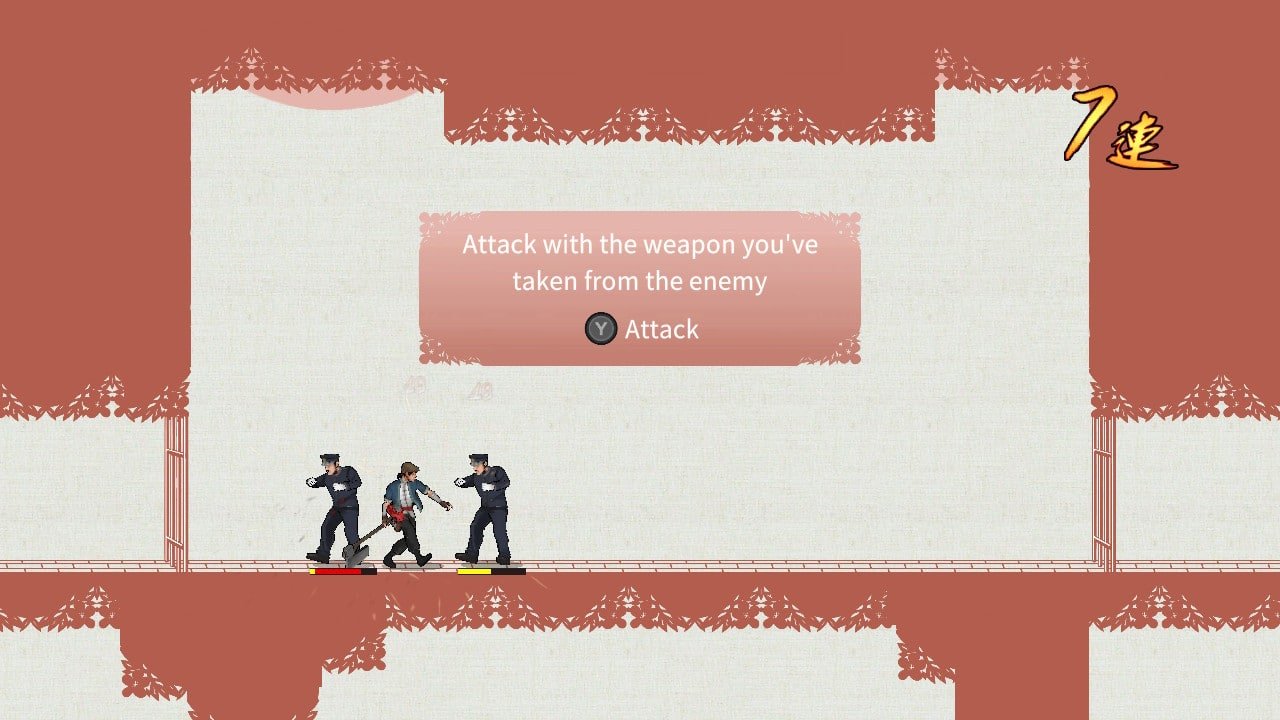
As you venture through levels, you will be challenged by enemies, traps, and often both at the same time. The foes you come up against are each armed with a weapon, and a lot of the combat is focused on figuring out the timing to dodge each weapon's attacks. You can unleash an unending barrage of basic attacks against your foes, and also have a few stronger abilities, like a ground-pound or flying kick, that use up stamina.
The real fun hook in the combat comes when you drop an enemy to less than half your health and can fling the red sash Tianding wears at them. They get cocooned up in the sash and the game drops to slow-motion for a few seconds to let you aim where you'd like to throw them. At that moment, the sawblades, automatic weapons, and deadly pits around the levels become an asset that you can use to eliminate your foes with a well-aimed throw.
Turning traps against your enemies isn't the only trick hidden in your sash, though. Each time you grab an enemy with it, you also steal whatever weapon they were equipped with. Yup, every weapon that you come up against can be utilized against your foes. This game goes for simplicity, in that each weapon is used with the exact same attack button, but really nailing the combat requires thinking about which weapons are around you, which ones to grab, and how to best utilize them.
And let me tell you, there are few things that feel better than ripping a baton out of a corrupt police officer's friend and using it to take down his buddy who is aiming a rifle at you.
Upgrades are a bit Odd

The only part of The Legend of Tianding that feels odd to me is its upgrade system. There are big upgrades that you unlock to your health, stamina, and healing abilities as you progress through the story, but then a ton of other, smaller upgrades that you get throughout the world.
First up are artifacts that you find just about everywhere that give you tiny, incremental bonuses. We're talking about things like “Get one extra round when you steal a rifle” or “drop 10% fewer coins when you die”. They aren't game-changing differences, but they are still nice. It honestly feels like these are the sorts of upgrades you'd expect to see as the in-between rewards on a webbed skill tree (think Final Fantasy X), but instead of gaining experience for things like finding a hidden corner of a level or giving some coins to a beggar, you get a specific little upgrade instead.
At first, I was kind of put off by this, but eventually, I started getting excited to see what each new boost would be. It's also super cool that each one is some sort of cultural artifact, and the pause menu gives you a brief historical blurb about each of them.
Gotta Have Those RPG Elements

The other major upgrade path is more like a character build option. Throughout your journey, you find talismans that you can equip to make bigger changes to your playstyle. These might significantly reduce the damage you take from traps, make every stolen weapon transform into a specific type you know you like, or even give you the ability to do an extra jump in the air. You can only equip a certain amount of talismans at a time, so changing these up can really change the feel of the game.
Finally, there are also vendors where you can purchase upgrades to your weapons and your healing abilities. As you adventure, each checkpoint that you come across refills the number of steamed buns you are carrying, which you can consume to recover some life. Buying a bigger “food pouch” allows you to carry more steamed buns. Pretty straightforward, right? On the other hand, the weapon merchant just always has a new weapon in stock, which I guess is just a damage boost over the basic weapon you've got before you start stealing them from enemies, but how much of a boost is never really explained. I upgraded whenever I had the cash, but since I didn't really know what the upgrade was getting me I didn't feel a lot of pressure to save up for them.
On Difficulty
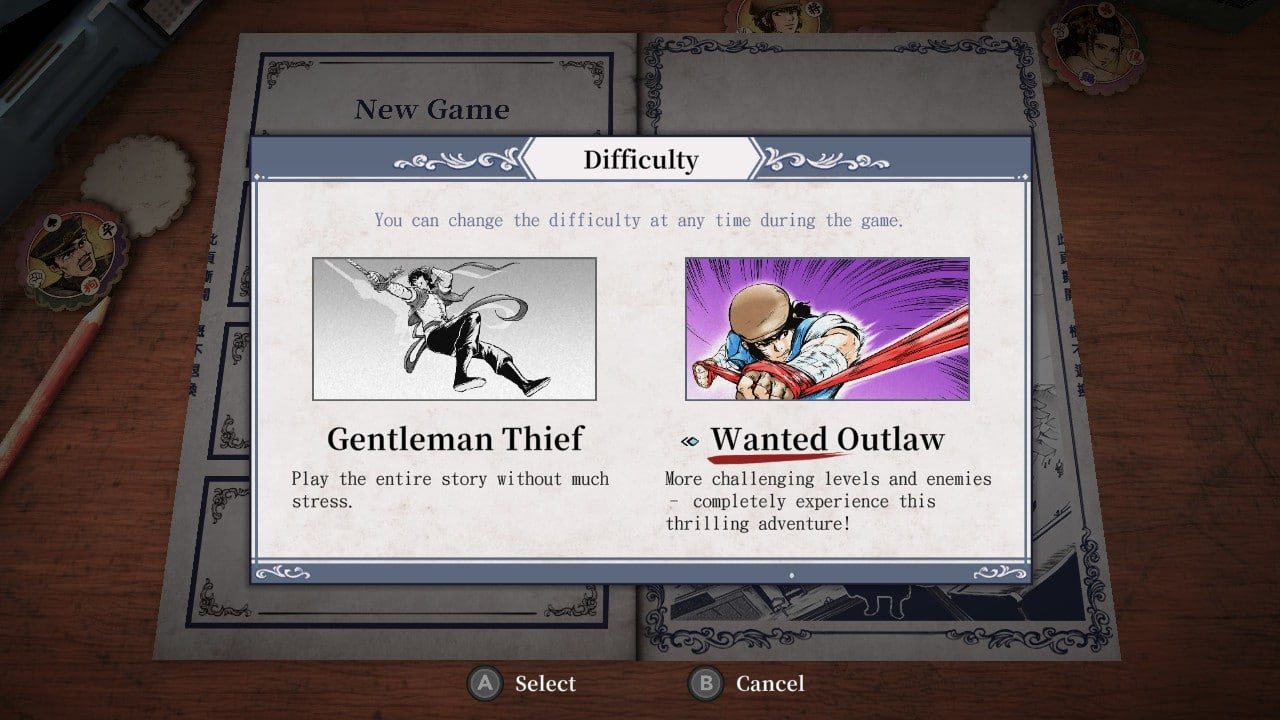
On the default difficulty setting, most of The Legend of Tianding is pleasantly playable. There are a few combat encounters and platforming challenges that can be a bit tricky, but without ever feeling entirely unfair. The boss battles ramp up the challenge pretty starkly, but that’s what you’d expect in a boss fight. When you do die, the game is super forgiving, letting you restart just a few steps from where you were with only the loss of a few coins.
There was one boss fight partway through where I really struggled to understand the patterns. I tried over and over again, but couldn’t really figure out how to get through this thing. For a moment, I even lowered from the difficulty to the “Gentleman Thief” setting, which acts as the game's story mode. I unpaused, then thought “No, I can do this”, and set it back to default. With new determination, I made it through in just a few more tries.
The Final Fight

The end fight in this game absolutely destroyed me. I could see the patterns, but the boss hit so hard that any mistake was devastating. It’s not uncommon for me to let a game go when I get to a final fight that just feels overwhelming, but I was digging the gameplay and story in The Legend of Tianding that I left eh boss encounter to replay some levels, knock out some side quests, and buy some more upgrades. When I went back, I got to the second stage of the fight… and then got stuck again.
At this point, I’d spent the better part of a morning working at overcoming this fight. I was well within my rights to just give up and walk away, but I didn’t I went back and played more levels, found more secrets, and bought the strongest sword that I could! Then I went back, and still had a hell of a time against the boss.
A full twenty-four hours after I first got to the boss, I finally made it through his second stage. I fully depleted his left bar and left him lying on the ground, defeated. But… the game didn’t end. I didn’t see credits. Instead, the fight continued into a third stage. I sat there, dumbfounded, and watched as my full life bar got drained in two hits.
Then I shut off my Switch, set it down, and wrote this section of the review.
A Second Opinion from CapsuleJay!
Compared to Troy, I was only able to spend a brief period of time with Legend of Tianding. During my 3-hour stream of the game, I was able to tackle the first 2 chapters of the campaign and get a good enough feel for the game to offer up some quick impressions.
Pros
When I saw the first promotional clips of this game a few months back, it immediately made a strong impression. This game is absolutely gorgeous! I love its slick comic book-style graphics and stylish animations. The visuals are complemented by a beautiful OST of traditional Chinese music. The overall aesthetic package this game offers is truly top-notch among indie games.
Much like the aesthetics, the mechanics of Legend of Tianding are highly polished. Once I got the hang of the combat, I had a blast stealing enemy's weapons, ricocheting goons off of each other, and flipping through the air. When I got into a flow, controlling Tianding felt silky smooth, somewhere between Strider and Spider-Man. The platforming sections were also quite solid. I liked the way the game lets you use your fighting moves to modify the trajectory of your jumps in a similar manner to a Metroidvania like Guacamelee.
Cons
While I loved the action stages of Legend of Tianding, I had mixed feelings about the parts in between. While I am definitely interested in the cultural and historical aspects of this game's story, the dialog didn't really grab me. Similarly, the gameplay between levels, which mostly consists of running around town to talk to NPCs and completing fetch quests, dragged a bit for me after a while. At a certain point, I was eager for characters to stop talking about the things they were going to do and actually go do them.
Takeaway
From what I had a chance to play, there is a lot to like about Legend of Tianding. With fun combat and a striking presentation, I'm definitely interested in sitting down with it again. I'm hoping the issues I had with pacing between stages were just a matter of the game setting things up that will pay off later.
Final Thoughts
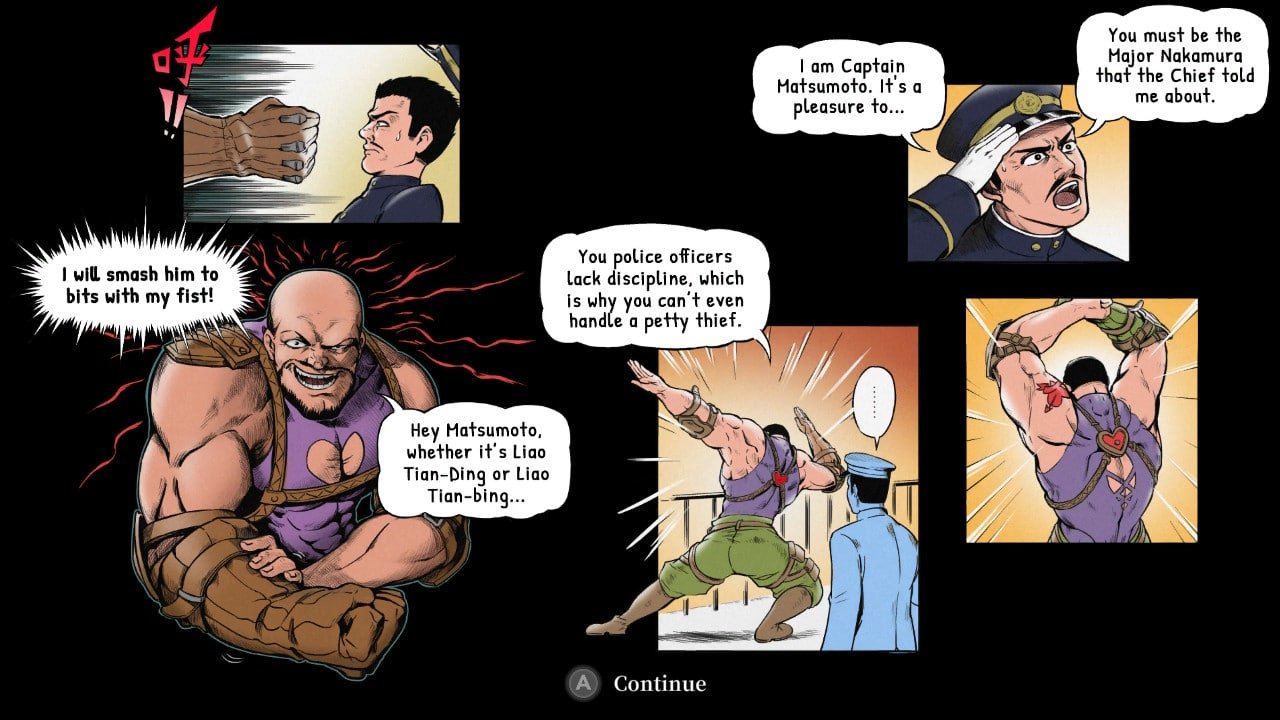
I am kind of surprised at how much I am loving this game. The art style is really fantastic, which I knew before I went into it, but the first moment I saw the action in motion was still mindblowing. Add on to that the story really has me interested in Tianding's adventures and how they will turn out. It's got me so hooked that I'm really looking forward to reading his Wikipedia page.
Finally, the combat and the level design in this game are really fantastic. Most encounters aren't difficult, but the way that throwing out your sash works into the flow means that every fight is interesting. On top of that, there are loads of boss battles that change up the way you play that are super fun and satisfying to overcome. Some of them actually top a lot of the fights from Metroid for me.
I just wish that final fight was a tad easier to play.
This game is great. I went in expecting something fun, but the more time I've spent with it the more I've fallen in love with it. If it weren’t for that steep difficulty spike at the end, I think I’d love it even more. If you're a fan of side-scrolling action platformers, manga aesthetics, or folklore, The Legend of Tianding is absolutely a game to check out.
Geek to Geek Rating: 4 out of 5 steamed bun Stars
Another final thought: I went back and fought the boss on the lower difficulty so I could see the game through. It turns out that on the Story mode that final stage of the boss fight doesn't happen, so I pretty quickly got to see a final cutscene that literally made me cry.
I really liked this game a lot, y'all.

